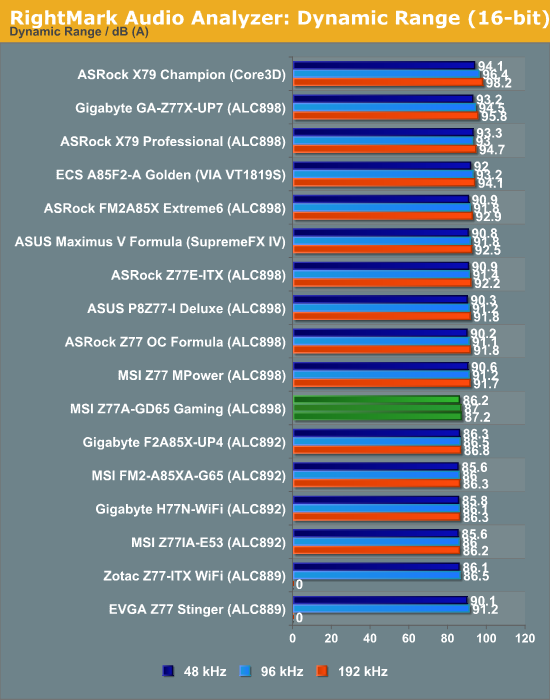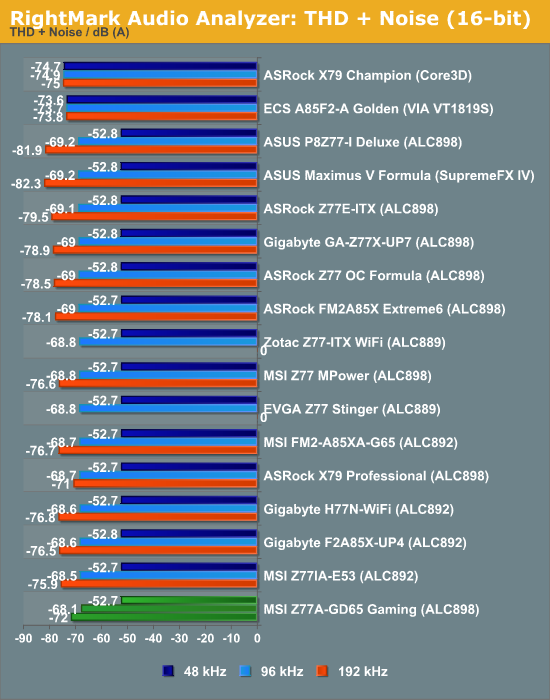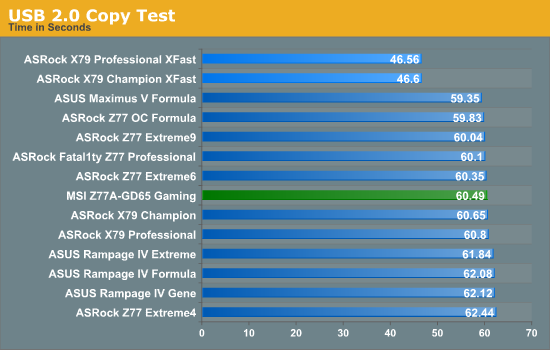MSI Z77A-GD65 Gaming Review
by Ian Cutress on April 18, 2013 12:00 PM EST- Posted in
- Motherboards
- MSI
- Z77
Rightmark Audio Analyzer 6.2.5
In part due to reader requests, we are pleased to include Rightmark Audio Analyzer results in our benchmark suite. The premise behind Rightmark:AA is to test the input and output of the audio system to determine noise levels, range, harmonic distortion, stereo crosstalk and so forth. Rightmark:AA should indicate how well the sound system is built and isolated from electrical interference (either internally or externally). For this test we connect the Line Out to the Line In using a short six inch 3.5mm to 3.5mm high-quality jack, turn the OS volume to 100%, and run the Rightmark default test suite at 48 kHz, 96 kHz and 192 kHz. We look specifically at the Dynamic Range of the audio codec used on board, as well as the Total Harmonic Distortion + Noise.


For an ALC898 chip on a gaming motherboard, the audio solution performs quite poorly. Initially my test had interchannel leakage, caused by SoundBlaster being enabled. While disabling this improved the test, the final results are a bit of a shock, being down in output and distortion compared to the competition.
USB 3.0 Backup
For this benchmark, we run CrystalDiskMark to determine the ideal sequential read and write speeds for the USB port using our 240 GB OCZ Vertex3 SSD with a SATA 6 Gbps to USB 3.0 converter. Then we transfer a set size of files from the SSD to the USB drive using DiskBench, which monitors the time taken to transfer. The files transferred are a 1.52 GB set of 2867 files across 320 folders – 95% of these files are small typical website files, and the rest (90% of the size) are the videos used in the WinRAR test.


MSI does well in terms of absolute USB 3.0 speed, although we have no extra controllers to compare. It happily makes a change from older MSI models that were ~20% slower in USB 2.0.
DPC Latency
Deferred Procedure Call latency is a way in which Windows handles interrupt servicing. In order to wait for a processor to acknowledge the request, the system will queue all interrupt requests by priority. Critical interrupts will be handled as soon as possible, whereas lesser priority requests, such as audio, will be further down the line. So if the audio device requires data, it will have to wait until the request is processed before the buffer is filled. If the device drivers of higher priority components in a system are poorly implemented, this can cause delays in request scheduling and process time, resulting in an empty audio buffer – this leads to characteristic audible pauses, pops and clicks. Having a bigger buffer and correctly implemented system drivers obviously helps in this regard. The DPC latency checker measures how much time is processing DPCs from driver invocation – the lower the value will result in better audio transfer at smaller buffer sizes. Results are measured in microseconds and taken as the peak latency while cycling through a series of short HD videos - under 500 microseconds usually gets the green light, but the lower the better.

The MSI DPC results are great, coming in under 200 microseconds easily. While during our test it hit a peak of 87, I noticed that when network activity was going on (I accidentally left Google Drive enabled) this would raise the DPC maximum to 178, which is still quite good.










37 Comments
View All Comments
IanCutress - Friday, April 19, 2013 - link
The x8/x8 + x4 vs. x8/x4/x4 difference will only showcase for those that need the PCIe slots, and I hope I have pointed this out in every review I have written. The x8 requirement for SLI will definitely feature in my future reviews, and I will be testing it on Haswell for you.After speaking with MSI, they *will* (because I'll hunt them down) be updating their website to make it more obvious to users. A lot of reviews will just go to the back end and copy/paste of the specifications rather than going through them like we try to do, to see where reality meets purpose. In recent months I have found a few glaring errors with both websites and manuals (!).
Ian
Sunstorm - Friday, April 19, 2013 - link
Many thanks Ian. The quality of the reviews here, as well as interactions like this between commentators and the authors are what really make you guys stand out as pretty much the best tech site out there, in my opinion. I'm glad that I have potentially flagged up this SLI issue that has not come up before.WeaselITB - Friday, April 19, 2013 - link
Wow, kudos on this. I'm not really in the market for a new motherboard (and I'm more of a ROG fan, anyway), but this sort of interaction is exactly why I keep reading Anandtech. Awesome.-Weasel
just4U - Thursday, April 18, 2013 - link
Realtek Sound?I noticed the SoundBlaster Cinema Sticker there yet it says Onboard sound is Realtek. Is it software emulation like what you see out of Asus? Or like Gigabyte's Killer series where it really is a SoundBlaster chip?
IanCutress - Friday, April 19, 2013 - link
Software Emulation; the Soundblaster Cinema software package is part of software stack, and enabled it by default. We had to disable it to run our RMAA audio tests properly as it interfered and raised an interchannel leakage error.Ian
just4U - Wednesday, April 24, 2013 - link
Such a shame.. MSI, use the real thing ok? That goes double for you Asus. Doesn't have to be SoundBlaster either but come on these are supposed to be a step above.benbenkr - Friday, April 19, 2013 - link
Why did you guys not test DPC latency on this board?Seriously, DPC latency is like one of the -->MOST<-- important thing to test given how much BS software which comes with all the motherboards these days.
IanCutress - Friday, April 19, 2013 - link
DPC Latency is on page 6, under System Benchmarks (http://anandtech.com/show/6902/6). It's a quick test and there are people who want the info, so we are happy to provide the extra data point. Some boards fail this test spectacularly, so it's good to get onto the manufacturers to fix it.tech6 - Friday, April 19, 2013 - link
Just another cynical marketing attempt to extract more money from the gaming community. Raise the price, make it black, put some cool graphics on it a loud contrasting color and call it a day.Lucian2244 - Saturday, April 20, 2013 - link
Isn't that how every business work?